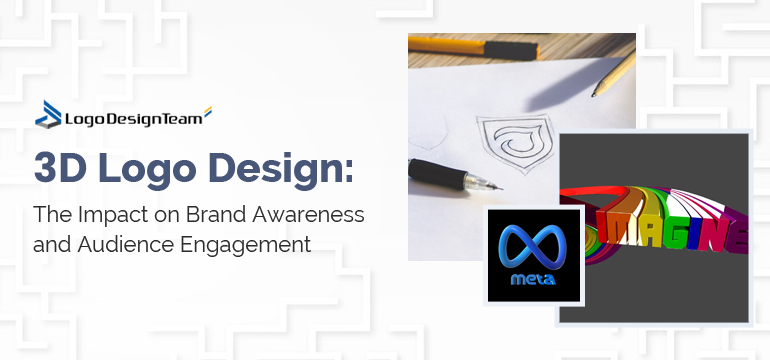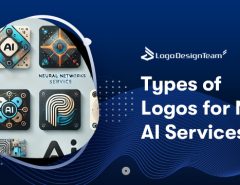In today’s ever-evolving digital landscape, where attention spans are fleeting and competition is fierce, standing out as a brand is more challenging than ever before. It’s no longer enough for a logo to be a static symbol on a letterhead or a storefront. Instead, logos are now in motion, adapting, and telling stories in ways we could only dream of a decade ago.
The concept of dynamic brand identities has taken the design world by storm. It’s a paradigm shift that transcends the boundaries of traditional logo design. Think of it as logos 2.0, where the once-static symbols come alive with movement, interactivity, and a unique ability to engage audiences on a deeper level.
In this blog, we embark on an exhilarating exploration of this dynamic logo revolution. We’ll journey through the motivations propelling this transformative change, the innovative technologies that bring it to life, and the pioneering brands that have embraced this brave new world.
Whether you’re a business owner seeking a competitive edge, a designer on the cutting edge of creativity, or simply someone intrigued by the future of branding, this is for you.
The Birth of Dynamic Brand Identities
In the not-so-distant past, logos were like family crests, unchanging symbols that stood as a steadfast representation of a brand’s identity. But in this digital age, where constant innovation is the norm and consumer engagement is paramount, the static logo has evolved into something more dynamic, more alive.
The Evolution:
Brands aren’t confined to static symbols; they’re fluid, ever-changing entities. This shift towards dynamic brand identities is a natural response to the digital age’s demands. A static logo couldn’t possibly keep pace with the rapid-fire interactions and content consumption of today’s consumers. They crave freshness, novelty, and interaction.
The Motivation:
At the heart of this transformation lies the desire for deeper engagement. Brands want to forge not just recognition but emotional connections with their audience. Static logos, while iconic, lacked the ability to tell stories, convey moods, or adapt to different contexts. Dynamic logos, on the other hand, are versatile storytellers, capable of expressing the essence and values of a brand in diverse scenarios.
Innovative Technologies:
It’s not just a desire for change that’s driving this evolution; it’s the technological advancements that make it possible. Animation, responsive web design, and interactive technologies have opened up new possibilities. These tools enable logos to dance, morph, and even respond to user interactions, breathing life into the brand identity.
The Pioneers:
Leading the charge into this brave new world are pioneering brands that recognize the potential of dynamic identities. From iconic logos that subtly transform over time to responsive designs that adapt to different screen sizes, these brands are setting new standards for what a logo can achieve.
The Tech Behind Dynamic Brand Identities
In this section, we’ll delve into the intricate machinery that powers dynamic brand identities. Behind the scenes, it’s a world of technology, creativity, and interactivity that makes logos come alive.
1. Animation & Motion Graphics:
At the core of dynamic brand identities is animation. Through the use of animation and motion graphics, logos gain a newfound vitality. They can smoothly transition between variations, morph into different forms, or even tell a brief story. Consider the Nike logo, which in a dynamic context, might stretch like a runner in motion, reinforcing the brand’s commitment to athleticism.
2. Responsive Design:
With the proliferation of various digital devices, responsiveness is key. Dynamic logos often come in different versions optimized for desktops, smartphones, and everything in between. These logos adapt intelligently, ensuring that they look just right on any screen. For instance, the Google logo subtly changes its size and spacing to fit the constraints of a mobile screen without losing its essence.
With the proliferation of various digital devices, responsiveness is key. Dynamic logos often come in different versions optimized for desktops, smartphones, and everything in between. These logos adapt intelligently, ensuring that they look just right on any screen. For instance, the Google logo subtly changes its size and spacing to fit the constraints of a mobile screen without losing its essence.
3. Interactivity:
Some dynamic logos invite user interaction. They respond to mouse movements, clicks, or touch gestures, creating an engaging experience. Take the WWF (World Wide Fund for Nature) logo as an example; it allows users to ‘paint’ the panda, symbolizing the impact of human actions on wildlife.
4. Generative Design:
The use of generative algorithms is pushing the boundaries of logo design. These algorithms create logos on the fly, generating variations based on specific parameters. This dynamic approach can yield thousands of logo possibilities, keeping a brand’s identity fresh and evolving. The MIT Media Lab’s logo is a famous example of generative design.
5. Augmented Reality (AR):
Incorporating AR into logos brings a whole new dimension to brand identity. By scanning the logo with a smartphone or AR device, users can unlock hidden content, animations, or even interactive games. Brands like Coca-Cola have explored this avenue, turning their static logos into gateways to immersive experiences.
6. Data-Driven Logos:
Imagine a logo that changes its appearance based on real-time data. This isn’t science fiction; it’s the future of branding. For instance, a weather app’s logo could reflect the current weather conditions in your location, or a sports brand’s logo might adjust based on a team’s performance.
The technological possibilities are vast and exciting, and they allow brands to experiment, engage, and evolve like never before. From animation and responsiveness to interactivity and generative design, these technologies are driving the transformation of logos into dynamic brand identities.
Dynamic Logos in Action
Let’s take a closer look at how brands across various industries are embracing dynamic logos to create memorable and engaging brand identities. These examples showcase the versatility and impact of dynamic logos in the real world.
1. Google: The Evolving Doodle:
Google is renowned for its playful approach to its logo. It frequently changes its iconic logo, known as the Google Doodle, to celebrate special events, holidays, and anniversaries. These dynamic variations not only reflect the brand’s creative spirit but also engage users in a fun and interactive way. The Google Doodle has become a beloved and anticipated part of the brand’s identity.
2. Airbnb: The Bélo:
Airbnb’s dynamic logo, called the Bélo, is a symbol of belonging and sharing. It takes the form of a heart, an “A,” and an upturned letter “A.” The brilliance lies in its adaptability; it can take on various colors and patterns to represent different cultures and communities. This flexibility underscores Airbnb’s commitment to inclusivity and celebrating diversity.
3. WWF: Animate for a Cause:
The World Wide Fund for Nature (WWF) logo is already iconic, featuring a giant panda. However, in its dynamic form, this logo becomes a canvas for a powerful message. Users can interact with the logo, ‘painting’ the panda to represent the impact of human activities on wildlife. This dynamic approach enhances WWF’s mission to raise awareness about endangered species.
4. MTV: Ever-Changing Identity:
MTV, known for its dynamic and youthful content, has a logo that reflects its brand perfectly. Over the years, MTV’s logo has continuously evolved. It morphs, twists, and adapts to different themes, genres, and cultural moments. This dynamic identity keeps the channel fresh and resonant with its target audience.
5. Warner Bros.: The Living Emblem:
Warner Bros. has breathed life into its classic shield logo. In dynamic contexts, such as movie openings and video games, the logo is no longer static. It takes on a three-dimensional form, rotating and shifting to create a sense of excitement and anticipation. This dynamic adaptation enhances the brand’s connection with audiences in the entertainment industry.
6. Pepsi: Generative Design for Freshness:
Pepsi’s logo experimentally embraces generative design. It’s not just one logo; it’s a system that generates endless logo variations. Each bottle of Pepsi can feature a slightly different logo, creating a sense of uniqueness and freshness for consumers. This approach keeps the brand ever-evolving and dynamic.
7. Toyota: AR Logo for Interaction:
Toyota has taken its logo into the realm of augmented reality (AR). By scanning the logo with a smartphone app, users can experience various interactive animations and even take a virtual tour of Toyota’s history. This dynamic approach bridges the physical and digital worlds, engaging users in an immersive brand experience.
8. CNN: Data-Driven Logos:
News network CNN has explored data-driven logos during election coverage. The logo’s design changes in real-time to reflect the status of an election. For instance, it can adjust its color to indicate which political party is leading. This dynamic logo adds an extra layer of information and engagement to the news broadcast.
These examples illustrate how dynamic logos are not limited to a single industry or approach. Instead, they showcase the creative potential and adaptability of dynamic branding. From celebratory Google Doodles to interactive WWF logos and evolving MTV identities, dynamic logos are reshaping how brands connect with their audiences.
The Benefits of Dynamic Logos
Dynamic logos offer a myriad of advantages for brands willing to embrace this innovative approach to visual identity. In this section, we’ll delve into the benefits that dynamic logos bring to the table, showcasing why they are a valuable asset for modern businesses.
1. Memorable Brand Interactions:
Dynamic logos create memorable brand interactions. When a logo evolves or adapts, it captures the audience’s attention. These interactions, whether through animation, color changes, or other dynamic elements, leave a lasting impression. For instance, Google’s dynamic Doodles make users eagerly anticipate what the search giant will come up with next, enhancing the brand’s memorability.
2. Enhanced Engagement:
Dynamic logos are inherently engaging. They invite users to interact, whether through clicks, scrolls, or augmented reality experiences. This engagement fosters a deeper connection between the brand and its audience. For example, when users participate in changing the colors of the WWF panda logo to represent environmental changes, they become active participants in the brand’s mission.
3. Adaptability Across Platforms:
In a digital age where brands exist across various platforms, dynamic logos are adaptable. They can be optimized for different screens, devices, and contexts. Whether on a website, mobile app, social media, or even physical packaging, a dynamic logo can seamlessly adjust to provide the best brand experience.
4. Storytelling and Brand Narrative:
Dynamic logos enable storytelling. Through logo animations and variations, brands can convey their narratives effectively. These stories can include celebrating cultural diversity, emphasizing social causes, or highlighting product innovations. Airbnb’s Bélo, with its customizable patterns, tells a story of belonging and inclusivity.
5. Brand Evolution and Modernity:
Dynamic logos convey a sense of brand evolution and modernity. They show that a brand is forward-thinking, innovative, and in tune with contemporary trends. This appeals to audiences looking for fresh and relevant experiences. MTV’s ever-changing logo reflects its commitment to staying current with youth culture.
6. Increased Brand Visibility:
Dynamic logos often have shareable and viral elements. Users are more likely to share and talk about logos that change or offer interactive experiences. This word-of-mouth and social media sharing increase a brand’s visibility and reach. For example, when Google creates a captivating Doodle, it becomes a trending topic and spreads across the internet.
7. Versatility in Branding Campaigns:
Dynamic logos are versatile for branding campaigns. They can be adjusted to align with specific marketing messages, events, or seasons. Pepsi’s generative logo, for instance, can create endless variations to match various product campaigns.
8. Data-Driven Insights:
Some dynamic logos, like CNN’s data-driven logo during elections, offer data-driven insights. They provide real-time information to users, making them valuable tools for conveying complex data or news. This not only enhances user engagement but also positions the brand as a trusted source of information.
Incorporating a dynamic logo into a brand’s identity can provide a competitive edge in today’s fast-paced and visually-driven world. These benefits collectively contribute to making dynamic logos an integral part of the future of brand identities.
Challenges and Considerations in Dynamic Logo Design
While dynamic logos offer numerous advantages, they also come with their set of challenges and considerations. In this section, we’ll explore these factors, helping brands understand what to expect and how to navigate the dynamic logo design process effectively.
1. Design Complexity:
Creating a dynamic logo is more complex than designing a static one. It requires careful planning to ensure that the logo’s dynamic elements align with the brand’s identity and message. Designers need to strike a balance between creativity and functionality to avoid overwhelming or confusing users.
2. Consistency Across Platforms:
Maintaining consistency across various platforms and devices can be challenging. A dynamic logo should adapt seamlessly to different screen sizes, orientations, and resolutions. Ensuring that the logo looks and functions as intended on a smartphone, tablet, desktop, or even a smartwatch requires thorough testing and adaptation.
3. Loading Times and Performance:
Dynamic logos often involve animations or interactive features that can impact loading times and website performance. Brands need to optimize their dynamic logos to ensure fast loading, especially in a mobile-first world where users have little patience for slow websites.
4. Brand Recognition:
Dynamic logos may risk diluting brand recognition if not executed carefully. While change and innovation are essential, it’s crucial to strike a balance between evolution and maintaining core brand elements that users recognize and associate with the brand. Too drastic a change can lead to confusion.
5. Accessibility and Inclusivity:
Brands must consider accessibility and inclusivity in dynamic logo design. Ensuring that dynamic elements are usable and understandable by all, including individuals with disabilities, is essential. An overly complex dynamic logo could alienate some users.
6. Technical Implementation:
Dynamic logos often require technical expertise to implement effectively. Brands may need to collaborate with developers and user experience designers to ensure that the logo functions smoothly across platforms. This adds a layer of complexity to the design process.
7. User Experience Testing:
Extensive user experience testing is crucial to refine dynamic logos. Gathering feedback from users across different demographics and devices helps identify potential issues and allows for iterative improvements.
8. Brand Strategy Alignment:
Dynamic logos should align with the brand’s overall strategy and messaging. The dynamic elements should enhance the brand’s story and mission rather than detract from it. Brands must consider how dynamic logos fit into their broader marketing and branding efforts.
9. Compatibility with Brand Values:
Dynamic logos should align with the brand’s values and mission. Brands need to ensure that the dynamic elements don’t clash with their ethical or social stances. For example, a playful animation might not be suitable for a brand advocating environmental sustainability.
10. Longevity and Evolution:
Brands should think about the long-term implications of dynamic logos. Will the chosen dynamic elements remain relevant and effective as the brand evolves? A logo that relies on a trendy technology or cultural reference might need frequent updates to stay current.
Addressing these challenges and considerations requires a strategic approach to dynamic logo design. Brands should view dynamic logos as an evolving aspect of their identity, continually refined to align with changing user expectations and brand objectives.
Conclusion
As we wrap up our exploration of dynamic logo design, it’s evident that this approach represents more than just a design trend—it’s a powerful tool for brands to connect, captivate, and stay relevant in the dynamic landscape of the digital age.
Dynamic logos, with their fluidity and adaptability, invite users into an interactive journey. They transform a static symbol into a living, breathing entity that can respond to user interactions or adapt to different contexts seamlessly.
This evolution isn’t just a visual gimmick; it’s a reflection of the brand’s commitment to staying dynamic, relevant, and user-centric.
As brands navigate the ever-changing waters of the digital landscape, dynamic logos offer a compass—a way to stay connected with audiences, make a memorable impression, and communicate the essence of the brand in a world where every pixel matters.
So, what’s next? The future of logos is dynamic, and the possibilities are limitless. Brands that embrace this evolution will continue to find innovative ways to connect with their audiences, tell compelling stories, and adapt to the ever-changing digital canvas.
The world of design is ever-evolving, and dynamic logos are at the forefront of this exciting transformation. They’re not just logos; they’re gateways to unforgettable brand experiences. The future is dynamic—embrace it, and let your brand’s logo come to life!
Stay dynamic, stay memorable, and stay connected!




